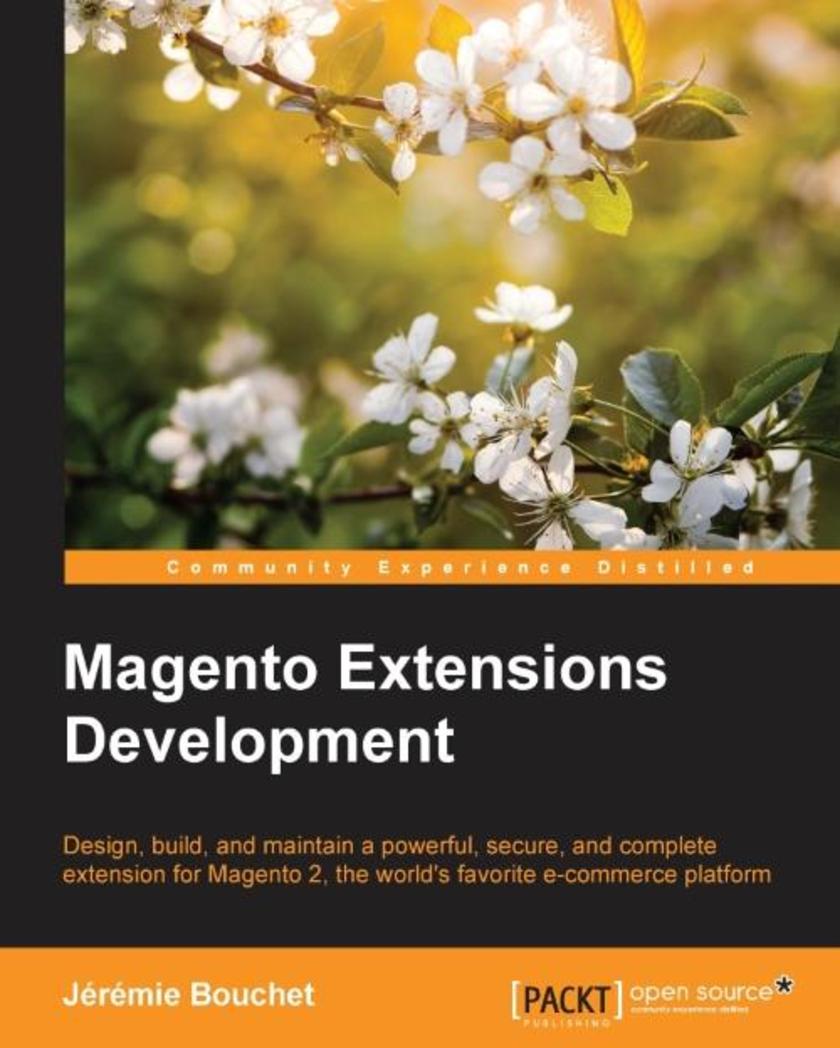
Magento Extensions Development
¥71.93
Design, build, and maintain a powerful, secure, and complete extension for Magento 2, the world’s favorite e-commerce platform About This Book Deploy a complete real-world extension step by step Construct your extension with the best and most up-to-date development methods Learn about team working and code sharing Who This Book Is For If you want to write a specific customization or a large new and full-featured extension on Magento 2, this book is intended for you. You must be an intermediate to professional-level developer in PHP to appreciate this book. What You Will Learn Build a fully-functional complex extension to add new functionality to Magento Register your code with GIT and work with your team Write new layouts and templates Set up a fully configurable grid and forms in the backend Create code unit tests and run them through TDD Propose localized contents Develop optimized extensions for a high-load environment Publish extensions on the Magento Connect Marketplace In Detail Magento has been revealed as the best and the most popular open source e-commerce platform in the world, with about 250k+ online stores. Magento 2 is the most recent version of this awesome toolset: every new and modern development techniques are used to offer a real modular approach and powerful architecture. The book will support you in the writing of innovative and complex extensions. Starting from the beginning, we will cover how to set up a development environment that allows you to be really efficient in your functionality writing, including GIT registering and many other development tools. We then move on to provide a large overview of the best practices to scale your module in a high-load environment. After these foundations, you will see how to use test driven-development (TDD) and unit tests to handle your code. We then build a complex extension together, step by step, and internationally-ready. Next, you will find out how to protect the users’ data. Finally, we will take a look a publishing the extension on the new Magento Connect marketplace and how to protect your intellectual property. After you read this book, you will know everything you need to know to become an invaluable extension editor, whether it is for your customers’ needs or for your own requirements. Style and approach This book takes a step-by-step approach to developing the extension and learning the new concepts of developments. Each topic is explained sequentially in the process of creating the extension, and punctuated by detailed explanations of the features of the code.
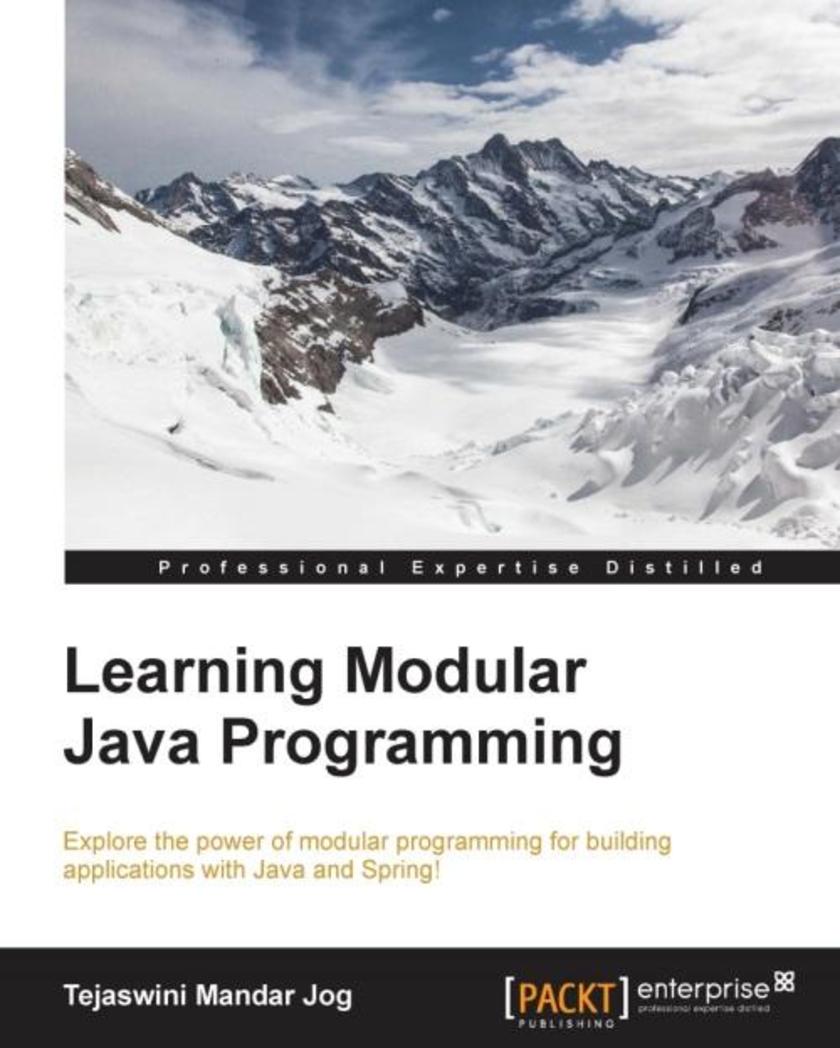
Learning Modular Java Programming
¥63.21
Explore the power of modular programming for building applications with Java and Spring! About This Book Understand the basic concepts of Modular Programming to build enterprise applications with Java Create short and precise code and eliminate recursion The book follows a step-by-step approach that makes implementing Modular Programming easy Who This Book Is For This book targets Java developers who have a basic knowledge of application development with Java and are interested in learning the Modular Programming approach for building reusable applications that are easy to test, and thus improve overall project management. What You Will Learn Learn about Modular Programming and what modules an enterprise application can be divided into. Set up a development environment and create a "Hello World" application. Start implementing a sample application from the presentation layer. Implement the persistence layer. Implement the business layer, wrapping up all of the modules with Contexts and Dependency Injection (CDI). Manage an application's life cycle. Learn how to secure Web applications. Test enterprise applications and their automation. Understand how to version source code using Source Code Management (SCM) systems such as GIT and SVN. In Detail Modular programming means dividing an application into small parts and then developing it. It is an approach taken by developers to build applications and helps them add efficiency in their development process, thus making it more effective. The book starts with the fundamentals of Modular Programming. Then we move on to the actual implementation, where we teach developers how to divide an application into different modules or layers (such as presentation, execution, security, lifecycle, services, and so on) for better management. Once readers are well-versed in these modules and their development, the book shows how to create bindings in order to join these different modules and form a complete application. Next, the readers will learn how to manage these modules through dependency injection. Later, we move on to testing; readers will learn how to test the different modules of an application. The book ends by teaching readers how to maintain different versions of their application and how to modify it. By the end of the book, readers will have a good understanding of modular programming and will be able to use it to build applications with Java. Style and approach This book is a practical guide to help readers learn Modular Programming with Java and build an enterprise-ready app along the way. The book is divided into three major sections. The first teaches the fundamentals of Modular Programming and how to implement them; the second teaches readers to combine and manage the modules developed; in the final section, the book explains the applications of Modular Programming.
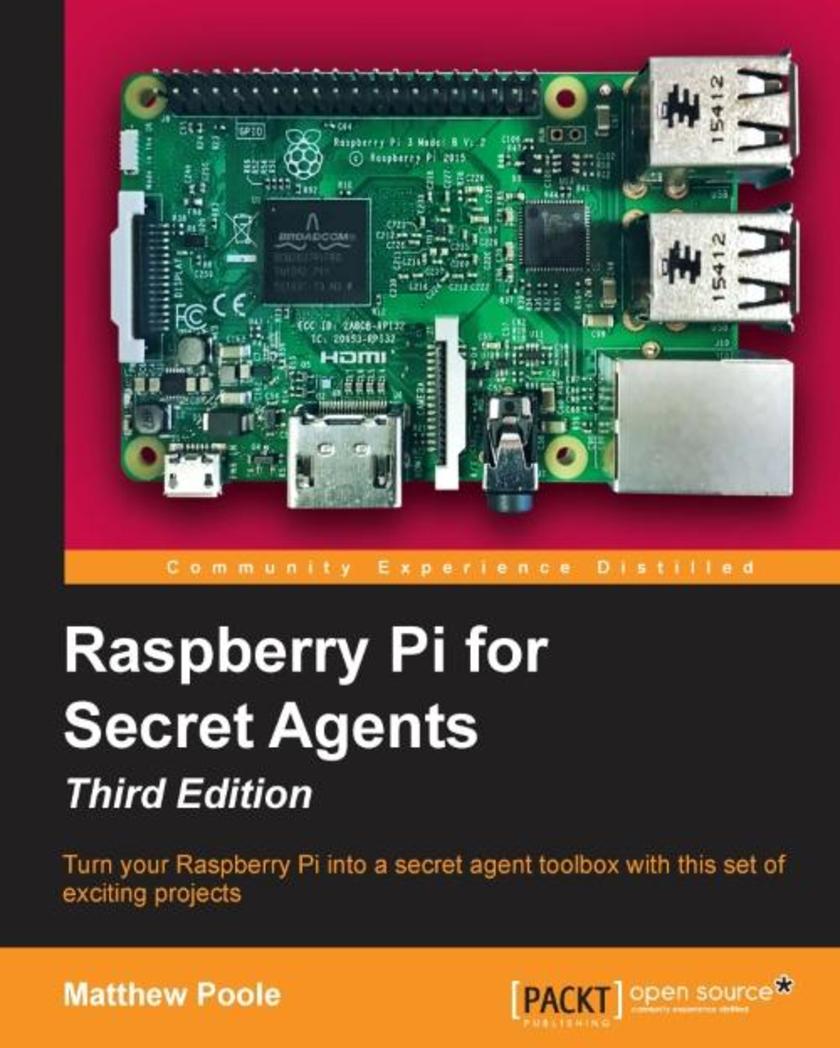
Raspberry Pi for Secret Agents - Third Edition
¥63.21
Turn your Raspberry Pi into a secret agent toolbox with this set of exciting projects About This Book Turn your Raspberry Pi into a multi-purpose secret agent gadget for audio and video surveillance, Wi-Fi exploration, or playing pranks on your friends Detect an intruder on camera or with sensors and set off an alarm or receive messages to your phone Find out what the other computers on your network are up to and make yourself anonymous on the Internet This book has been updated for new additions to your toolkit featuring the tiny, recently released Raspberry Pi Zero board Who This Book Is For This book is for those who are new to the Raspberry Pi Zero ,Raspberry Pi 2 or Raspberry Pi 3 and have some experience with the original Raspberry Pi models, and even for those budding secret agents who would like to use Pi Zero as a secret agent toolbox. No programming experience is assumed. Suitable for the novice and expert alike, each topic provides a fast and easy way to get started with exciting applications, with practical examples in every chapter. What You Will Learn Install and configure the Raspbian Jessie operating system for maximum mischief Detect an intruder with motion detection or a laser trip wire and set off an alarm Listen in to conversations from a distance over Bluetooth Distort your voice in weird and wonderful ways Track the Pi's whereabouts using GPS Connect your Pi to the mobile Internet using a 3G dongle and make yourself anonymous on the net Display secret messages and codes to fellow agents on a LED display In Detail This book is for all mischievous Raspberry Pi owners who’d like to see their computer transform into a neat spy gadget to be used in a series of practical pranks and projects. No previous skills are required to follow along, and if you’re completely new to Linux, you’ll pick up much of the basics for free. We’ll help you set up your Raspberry Pi Zero , Raspberry Pi 2 and Raspberry Pi 3 and guide you through a number of pranks and secret agent techniques that are so inconspicuous yet high on mischief. You’ll learn how to configure your operating system for maximum mischief and start exploring audio, video, or Wi-Fi techniques. We’ll show you how to record, listen, or talk to people from a distance and how to set up your own phone network. Then, you’ll plug in your webcam and set up a motion detector with an alarm and find out what the other computers on your Wi-Fi network are up to. Once you've mastered the techniques, we’ll combine them with a battery pack and GPS for the ultimate off-road spy kit. Style and Approach This easy-to-follow guide is for budding secret agents who want to create tools for mischief, stealth, and reconnaissance. It’s full of fun, practical examples and easy-to-follow recipes, guaranteeing maximum mischief for all skill levels.
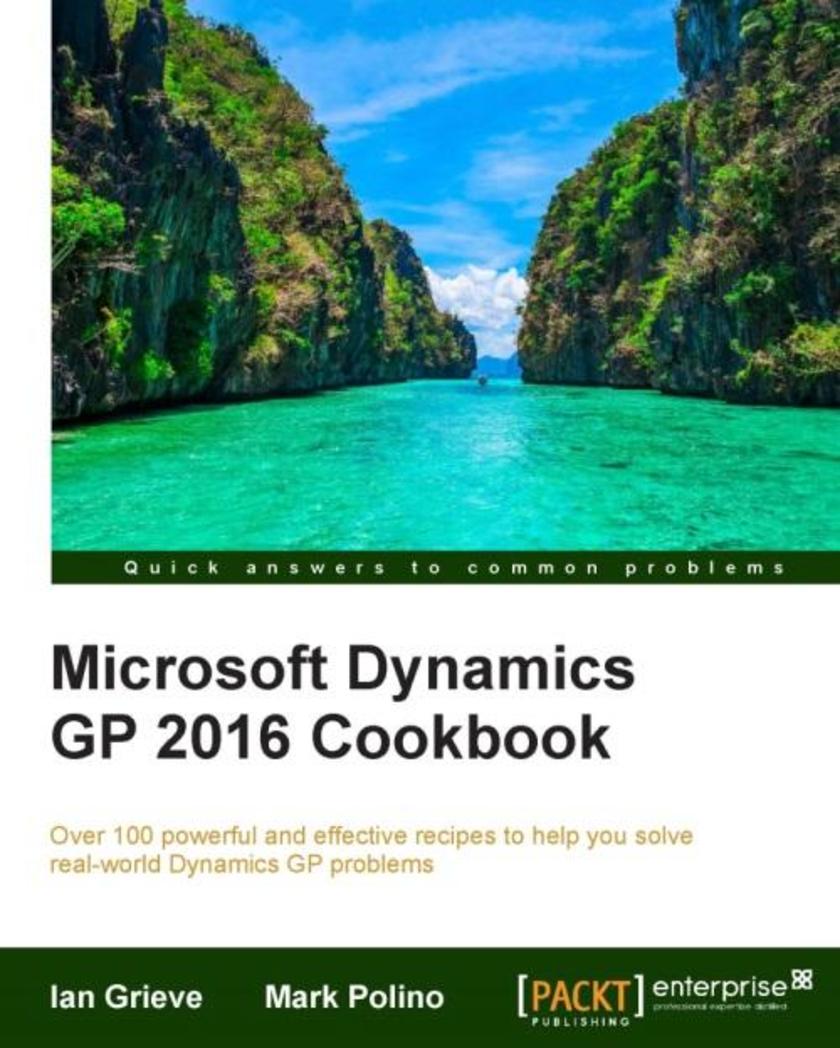
Microsoft Dynamics GP 2016 Cookbook
¥107.90
Over 100 powerful and effective recipes to help you solve real-world Dynamics GP problems About This Book Switch to Dynamics GP 2016 to take advantage of improved cloud support, workflow enhancements, and a more intuitive user experience Understand the various tips and tricks to master Dynamics GP, and improve your system’s stability in order to enable you to get work done faster Discover how to solve real-world problems in Microsoft Dynamics GP 2016 with easy-to-understand and practical recipes Who This Book Is For The book is for Dynamics GP users or Dynamics GP partners. It assumes that you have a basic understanding of business management systems and Microsoft Dynamics GP. What You Will Learn Explore the new enhancements in Dynamics GP 2016 Personalize Microsoft Dynamics GP to improve accessibility and efficiencies Maintain Dynamics GP and ensure proper operation of the system using optimum processes Efficiently organize Microsoft Dynamics GP to improve processes Leverage the power of SmartLists using proven tips and techniques and undocumented search functionalities Connect Microsoft Dynamics GP 2016 to Microsoft Office 2013 Enhance the usability of Microsoft Dynamics GP with hacks Expose the hidden features in Microsoft Dynamics GP to improve efficiency and get more from the system Deploy and use the Support Debugging tool to trace, locate, and resolve problems encountered by users Explore PowerBI and how it can be used with Dynamics GP 2016 In Detail The latest release of Dynamics GP 2016 offers a powerful, adaptable, and cloud enabled enterprise accounting software solution. The new version has experienced changes in serviced-based architecture, workflow, existing functionalities, and the introduction of plenty of new features. This book will help you get the most out of Dynamics GP quickly and effectively. This book picks up where implementation training leaves off. Whether you are new or experienced, you will find useful recipes to improve the way you use and work with Dynamics GP. The book starts with recipes designed to enhance the usefulness of Microsoft Dynamics GP by personalizing the look and feel of the application. Most of the recipes are designed to give you tips for a typical installation of Dynamics GP, including core financials and distribution modules. The book then moves through recipes that include automating Dynamics GP to allow users or administrators to focus on value adding tasks, connecting Dynamics GP to Microsoft Office, exposing hidden features in Dynamics GP, PowerBI, and much more! Style and approach This book follows a recipe-based approach with a problem-solution mind-set. Each recipe is independent of the others; real-world tested, and designed to be used immediately.
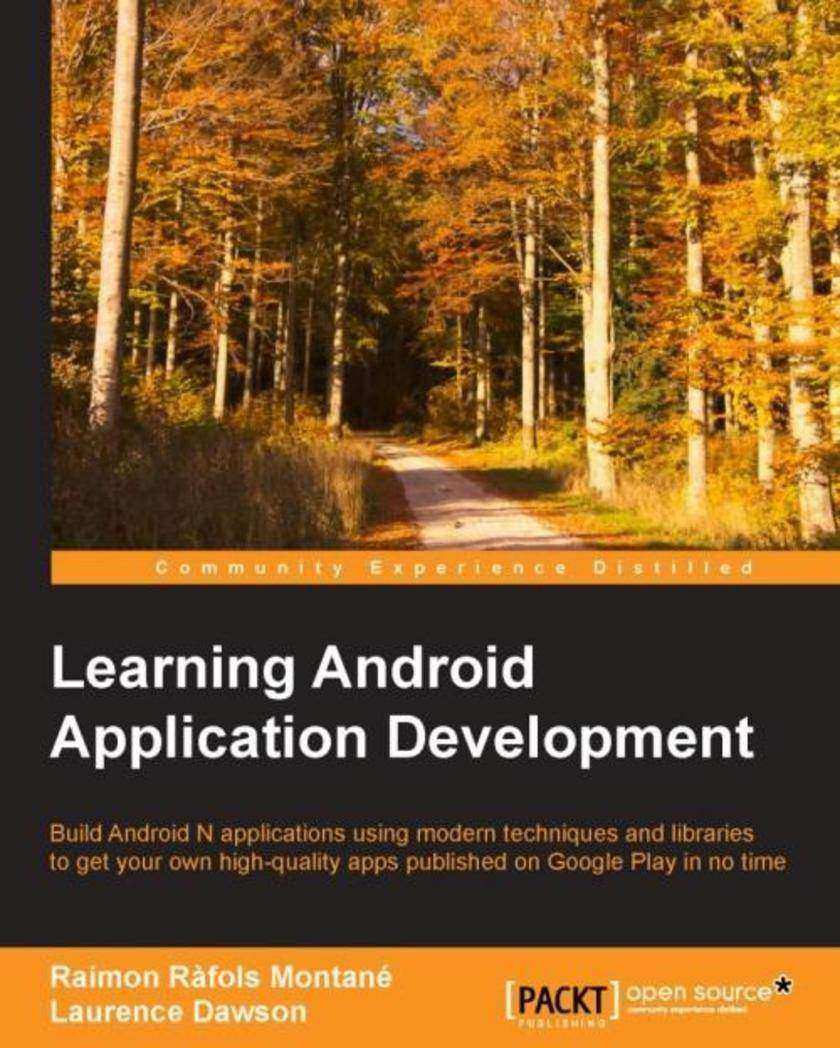
Learning Android Application Development
¥71.93
Build Android N applications using modern techniques and libraries to get your own high-quality apps published on Google Play in no time About This Book Get started with Android development, from the installation of required tools to publishing to the market Make your applications Android N ready—Android has evolved quite a lot since the very beginning and so has their Software Development Kit—so get up to speed Save time and improve the quality of your applications with widely used open source libraries and dependency management Who This Book Is For Want to get started with Android developmentStart here. What You Will Learn Get to know how to use popular open source libraries to reduce time to market and avoid re-inventing the wheel Automate your application’s testing phase to avoid last minute crashes Use dependency management to properly keep dependencies and updates under control Efficiently show huge amounts of items in a list Forget about memory and speed concerns Publish and monetize your Android applications on Google Play Persist your application data so it can continue working in offline mode Don’t let the UX break because of network issues In Detail The mobile app market is huge. But where do you startAnd how you can deliver something that takes Google Play by stormThis guide is the perfect route into Android app development – while it’s easy for new apps to sink without a trace, we’ll give you the best chance of success with practical and actionable guidance that will unlock your creativity and help you put the principles of Android development into practice. From the fundamentals and getting your project started to publishing your app to a huge market of potential customers, follow this guide to become a confident, creative and reliable mobile developer. Get to grips with new components in Android 7 such as RecyclerView, and find out how to take advantage of automated testing, and, of course, much, much more. What are you waiting forThere’s never been a better time – or a better way – to get into Android app development. Style and approach More than just a manual, this is an accessible route into Android development. Packed with examples that demonstrate how to put key concepts and ideas into practice, this guide isn’t just about learning, it’s about immediate development.
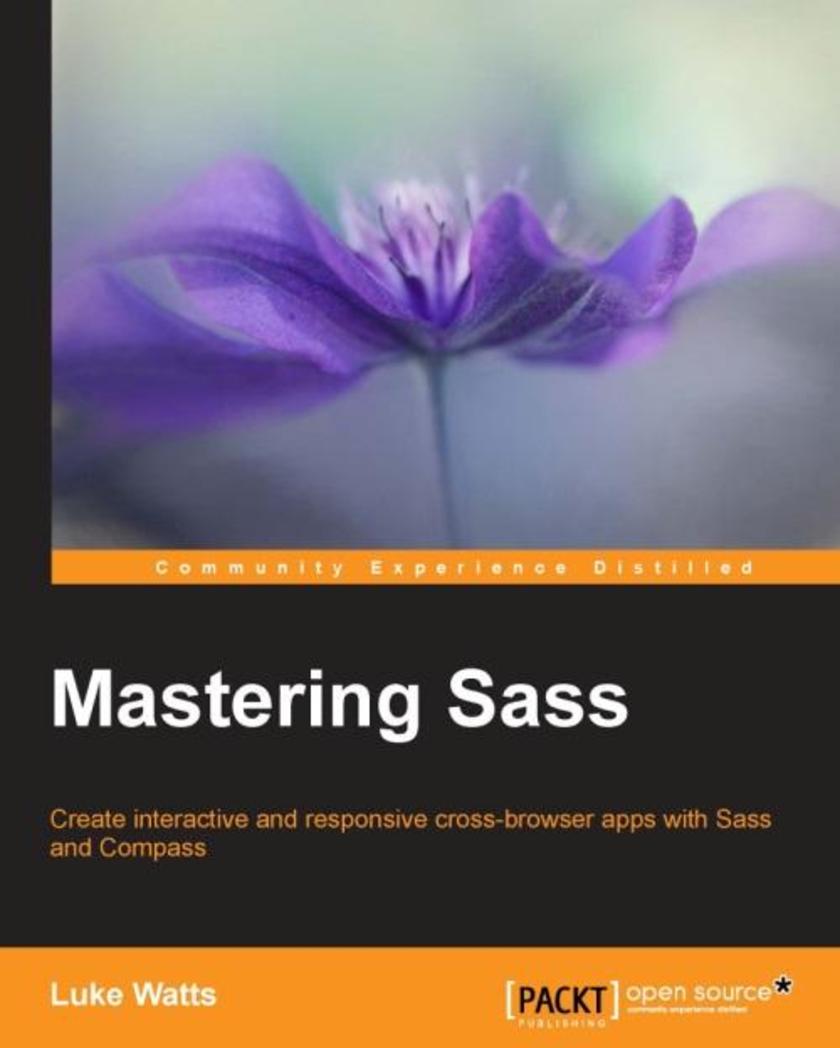
Mastering Sass
¥80.65
Create interactive and responsive cross-browser apps with SASS and Compass About This Book Create data-intensive, highly scalable apps using Sass and COMPASS Master the concepts of Sass and COMPASS and unleash your potential to develop enterprise-grade apps This book is an experts’ guide on leveraging Sass and COMPASS features Who This Book Is For This book is aimed at those who know CSS3 and HTML5 quite well and who've built a few small-to-medium-sized websites from scratch using Sass and Compass. What You Will Learn Master Sass and Compass features Familiarize yourself with CSS and HTML concepts that are vital for a good Sass workflow. Build real-world websites focusing on layouts and content aspects Work on a grid system using Compass and Susy Automate your workflow with Gulp Write functions and mixins to leverage the control flow In Detail CSS and Sass add elegance and excellence to the basic language, and consist of a CSS-compatible syntax that allows you to use variables, nested rules, mixins, inline imports, and much more. This book will start with an overview of the features in Sass and Compass, most of which you'll already be familiar; however, this will ensure you know what’s expected as the book goes deeper into Sass and Compass. Next you will learn CSS and HTML concepts that are vital to a good Sass workflow. After all, Sass exists to simplify writing CSS, but it won’t teach you how to make clean, scalable, reusable CSS. For that, you need to understand some basic concepts of OOCSS, SMACCS, and Atomic Design. Once you’ve brushed up on the important concepts, it’s time to write some Sass. Mainly you’ll write a few functions and mixins that really leverage control flow using @if / @else loops and you’ll learn how to figure out when and why things are going wrong before they bring you to a stop. Moving further, you’ll learn how to use @debug, @warn and @error to properly handle errors. You’ll also learn about Gulp and how to use it to automate your workflow and reduce your repetitive tasks. And finally you’ll learn about sourcemaps. With sourcemaps, you’ll be able to write, debug, and view your Sass and Compass all from within the browser. It’ll even LiveReload too! As a bonus, you’ll take a look at that funky Flexbox, currently all the rage! You’ll learn how powerful and flexible it really is, and how you can use it with Compass. Best of all, it falls back very gracefully indeed! In fact, you’ll be able to apply it to any existing project without having to change a line of the original CSS. Style and approach This book will provide readers with practical, actionable expertise to enhance their knowledge
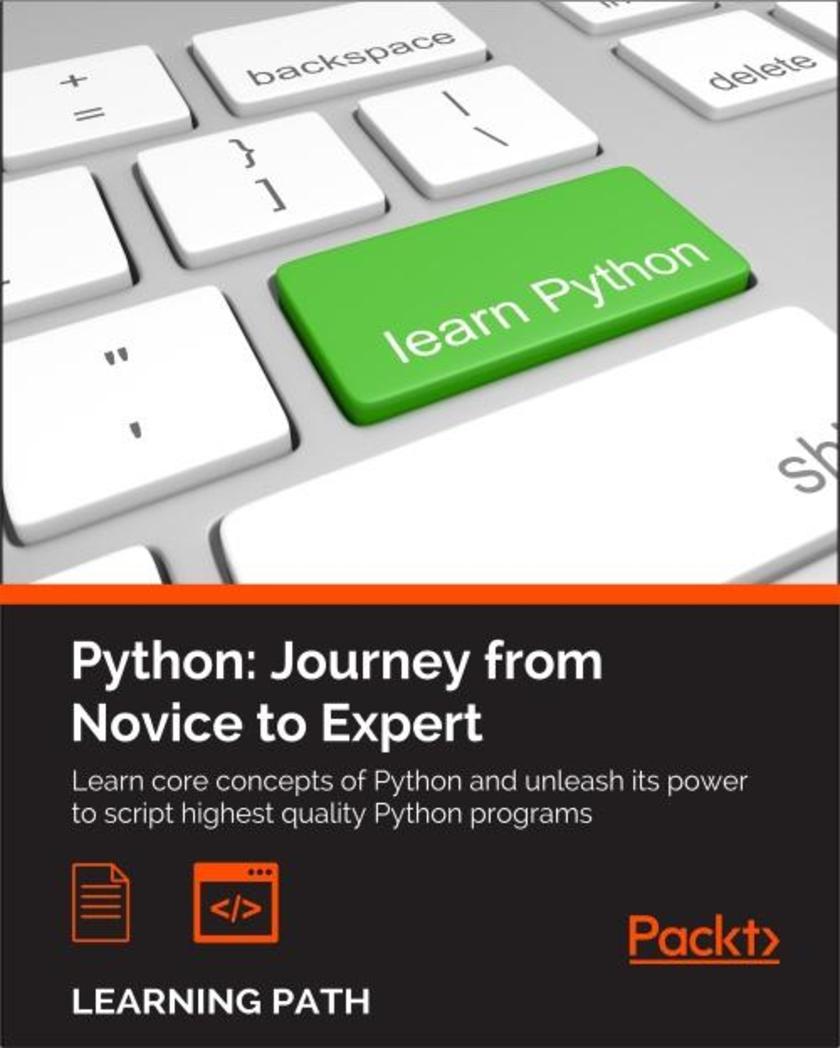
Python: Journey from Novice to Expert
¥179.84
Learn core concepts of Python and unleash its power to * highest quality Python programs About This Book Develop a strong set of programming skills with Pyhton that you will be able to express in any situation, on every platform, thanks to Python's portability Stop writing *s and start architecting programs by applying object-oriented programming techniques in Python Learn the trickier aspects of Python and put it in a structured context for deeper understanding of the language Who This Book Is For This course is meant for programmers who wants to learn Python programming from a basic to an expert level. The course is mostly self-contained and introduces Python programming to a new reader and can help him become an expert in this trade. What You Will Learn Get Python up and running on Windows, Mac, and Linux in no time Grasp the fundamental concepts of coding, along with the basics of data structures and control flow Understand when to use the functional or the object-oriented programming approach Extend class functionality using inheritance Exploit object-oriented programming in key Python technologies, such as Kivy and Django Understand how and when to use the functional programming paradigm Use the multiprocessing library, not just locally but also across multiple machines In Detail Python is a dynamic and powerful programming language, having its application in a wide range of domains. It has an easy-to-use, simple syntax, and a powerful library, which includes hundreds of modules to provide routines for a wide range of applications, thus making it a popular language among programing enthusiasts.This course will take you on a journey from basic programming practices to high-end tools and techniques giving you an edge over your peers. It follows an interesting learning path, divided into three modules. As you complete each one, you’ll have gained key skills and get ready for the material in the next module.The first module will begin with exploring all the essentials of Python programming in an easy-to-understand way. This will lay a good foundation for those who are interested in digging deeper. It has a practical and example-oriented approach through which both the introductory and the advanced topics are explained. Starting with the fundamentals of programming and Python, it ends by exploring topics, like GUIs, web apps, and data science.In the second module you will learn about object oriented programming techniques in Python. Starting with a detailed analysis of object-oriented technique and design, you will use the Python programming language to clearly grasp key concepts from the object-oriented paradigm. This module fully explains classes, data encapsulation, inheritance, polymorphism, abstraction, and exceptions with an emphasis on when you can use each principle to develop well-designed software.With a good foundation of Python you will move onto the third module which is a comprehensive tutorial covering advanced features of the Python language. Start by creating a project-specific environment using venv. This will introduce you to various Pythonic syntax and common pitfalls before moving onto functional features and advanced concepts, thereby gaining an expert level knowledge in programming and teaching how to * highest quality Python programs. Style and approach This course follows a theory-cum-practical approach having all the ingredients that will help you jump into the field of Python programming as a novice and grow-up as an expert. The aim is to create a smooth learning path that will teach you how to get started with Python and carry out expert-level programming techniques at the end of course.
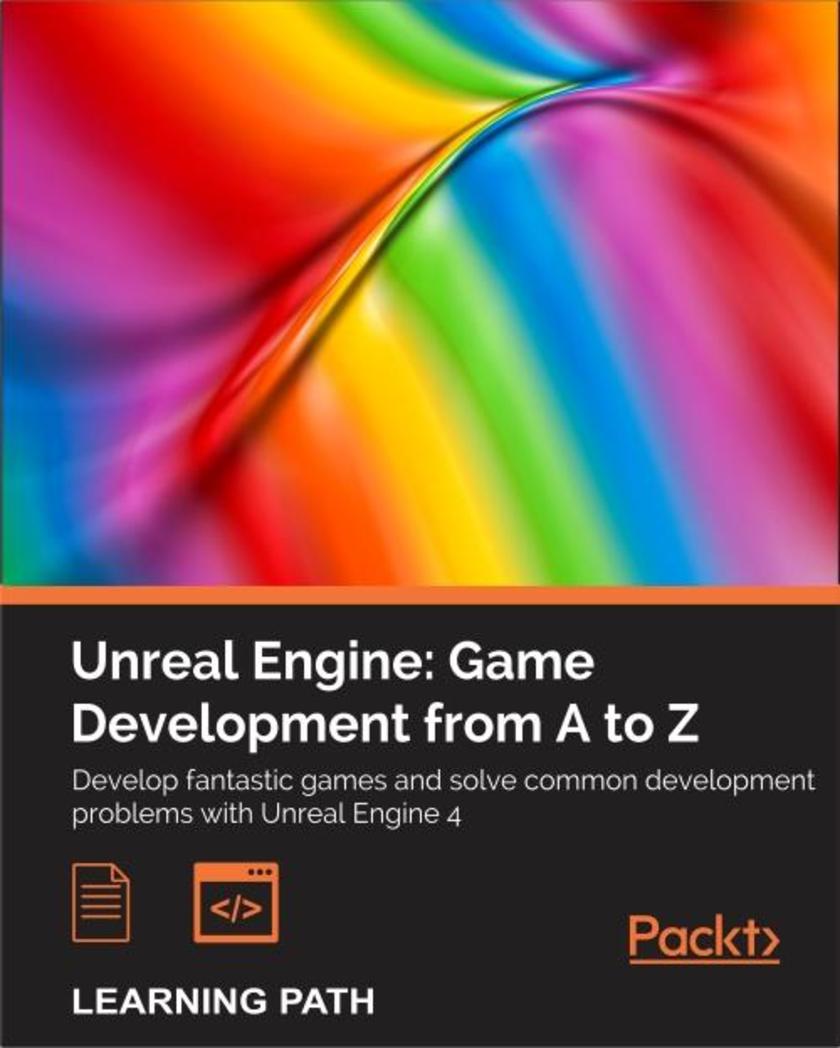
Unreal Engine: Game Development from A to Z
¥179.84
Develop fantastic games and solve common development problems with Unreal Engine 4 About This Book Investigate the big world of Unreal Engine, computer graphics rendering and Material editor to implement in your games Construct a top-notch game by using the assets offered by Unreal Engine, thereby reducing the time to download, create assets on your own. Understand when and why to use different features and functionalities of Unreal Engine 4 to create your own games Learn to use Unreal 4 by making a first person puzzle game, Blockmania, for Android. Who This Book Is For This path is ideal for those who have a strong interest in game development and some development experience. An intermediate understanding of C++ is recommended. What You Will Learn Explore the Unreal Engine 4 editor controls and learn how to use the editor to create a room in a game level Get clued up about working with Slate, Unreal’s UI solution through the UMG Editor Put together your own content and materials to build cutscenes and learn how to light scenes effectively Get tips and tricks on how to create environments using terrain for outdoor areas and a workflow for interiors as well using brushes Explore the ways to package your game for Android Devices and porting it to the Google Playstore Know inside out about creating materials, and applying them to assets for better performance Understand the differences between BSP and static meshes to make objects interactive In Detail Unreal Engine technology powers hundreds of games. This Learning Path will help you create great 2D and 3D games that are distributed across multiple platforms. The first module, Learning Unreal Engine Game Development, starts with small, simple game ideas and playable projects. It starts by showing you the basics in the context of an individual game level. Then, you'll learn how to add details such as actors, animation, effects, and so on to the game. This module aims to equip you with the confidence and skills to design and build your own games using Unreal Engine 4. By the end of this module, you will be able to put into practise your own content. After getting familiar with Unreal Engine’s core concepts, it’s time that you dive into the field of game development. In this second module, Unreal Engine Game Development Cookbook we show you how to solve development problems using Unreal Engine, which you can work through as you build your own unique project. Every recipe provides step-by-step instructions, with explanations of how these features work, and alternative approaches and research materials so you can learn even more. You will start by building out levels for your game, followed by recipes to help you create environments, place meshes, and implement your characters. By the end of this module, you will see how to create a health bar and main menu, and then get your game ready to be deployed and published. The final step is to create your very own game that will keep mobile users hooked. This is what you'll be learning in our third module, Learning Unreal Engine Android Game Development,Once you get the hang of things, you will start developing our game, wherein you will graduate from movement and character control to AI and spawning. Once you've created your application, you will learn how to port and publish your game to the Google Play Store. With this course, you will be inspired to come up with your own great ideas for your future game development projects. Style and approach A practical collection of bestselling Packt titles, this Learning Path aims to help you skill up with Unreal Engine by curating some of our best titles into an essential, sequential collection.
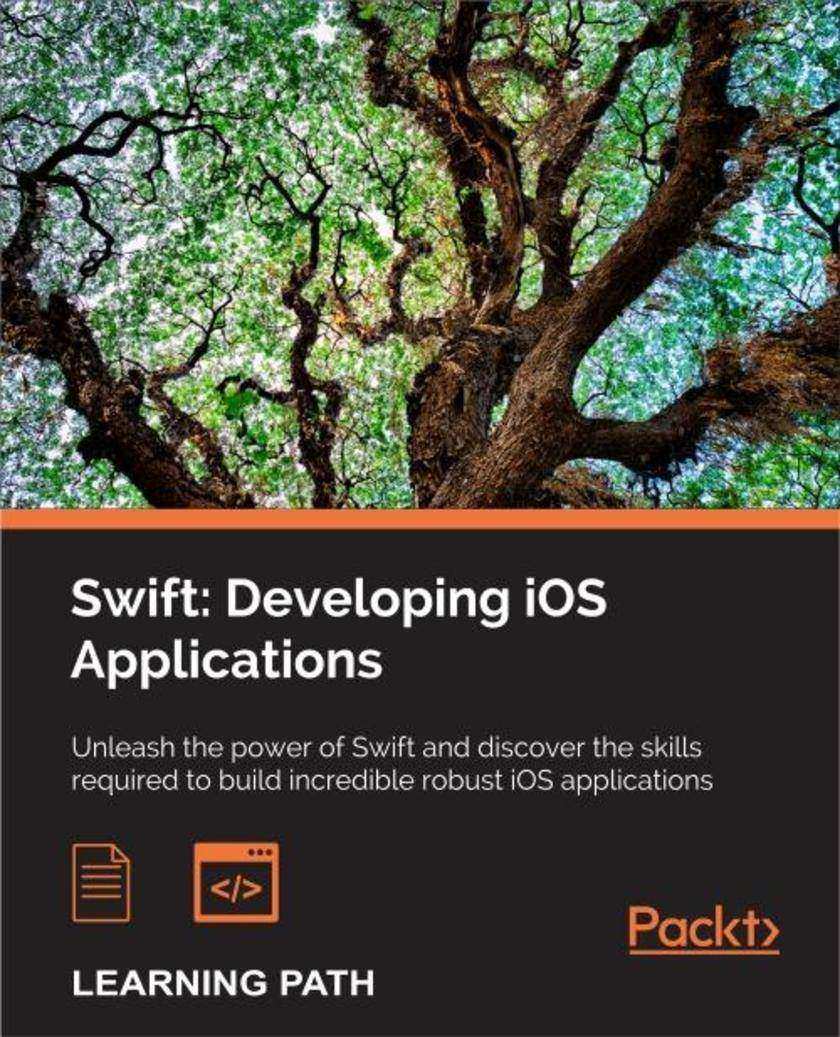
Swift: Developing iOS Applications
¥161.31
Unleash the power of Swift and discover the skills required to build incredible robust iOS applications About This Book Write expressive, understandable, and maintainable Swift 2 code with this hands-on course Unveil the complex underpinnings of Swift to turn your app ideas into reality Specialize in developing real iOS apps, and 2D and 3D video games using Swift and Cocoapods Dive deep into protocol extensions, learn new error handling model and use featured Swift design patterns to write more efficient code Who This Book Is For This course would be for app developers who are new to developing for iOS or OSX and are trying to get grips with Swift for the first time. What You Will Learn From a solid understanding of the Swift 2 language Get to know the practical aspects of how a computer program actually works Understand the paradigms used by Apple’s frameworks, so you are not intimidated by them Create a server in Swift to deliver JSON data to an iOS app Take advantage of Cocoapods to use third-party libraries Build games with SpriteKit and SceneKit Develop an app running on the cloud to act as an API server for your client’s apps Dive into the core components of Swift 2 including operators, collections, control flow, and functions Create and use classes, structures, and enums including object-oriented topics such as inheritance, protocols, and extensions Develop a practical understanding of sub*s, optionals, and closures Master Objective-C interoperability with mix and match Access network resources using Swift Implement various standard design patterns in the Swift language In Detail The Swift––Developing iOS Applications course will take you on a journey to become an efficient iOS and OS X developer, with the latest trending topic in town. Right from the basics to the advanced level topics, this course would cover everything in detail. We’ll embark our journey by dividing the learning path into four modules. Each of these modules are a mini course in their own right; and as you complete each one, you’ll gain key skills and be ready for the material in the next module. The first module is like a step-by-step guide to programming in Swift 2. Each topic is separated into compressible sections that are full of practical examples and easy-to-understand explanations. Each section builds on the previous topics, so you can develop a proficient and comprehensive understanding of app development in Swift 2. By the end of this module, you’ll have a basic understanding of Swift 2 and its functionalities. The second module will be the an easy-to-follow guide filled with tutorials to show you how to build real-world apps. The difficulty and complexity level increases chapter by chapter. Each chapter is dedicated to build a new app, beginning from a basic and unstyled app through to a full 3D game. The last two chapters show you how to build a complete client-server e-commerce app right from scratch. You’ll be able to build well-designed apps, effectively use AutoLayout, develop videogames, and build server apps. The third and the last module of our course will take an example-based approach where each concept covered is supported by example code to not only give you a good understanding of the concept, but also to demonstrate how to properly implement it. Style and approach This course includes all the resources that will help you jump into the app development .This course covers all the important aspects Swift application development and is divided into individual modules so that you develop your skill after the completion of a module and get ready for the next. Through this comprehensive course, you'll learn how to use Swift programming with hands-on examples from scratch to finish!
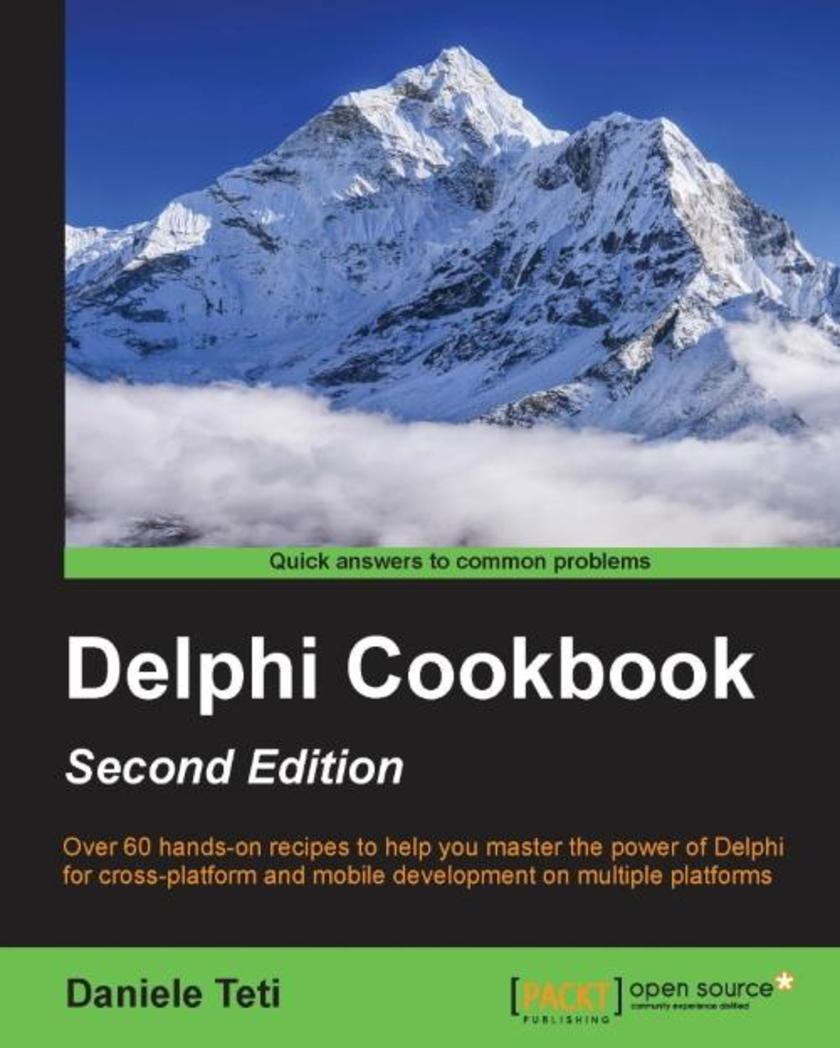
Delphi Cookbook - Second Edition
¥90.46
Over 60 hands-on recipes to help you master the power of Delphi for cross-platform and mobile development on multiple platforms About This Book Get to grips with Delphi to build and deploy various cross-platform applications Design, develop, and deploy real-world applications by implementing a single source codebase This swift guide will increase your productivity to develop applications with Delphi Who This Book Is For If you are an intermediate developer with a basic knowledge of Delphi and you want to develop cross-platform applications, then this book is for you. Familiarity with the fundamentals of RAD (Rapid Application Development) Studio is expected. What You Will Learn Develop visually stunning applications using FireMonkey Deploy LiveBinding effectively with the right OOP approach Create server-side programs to serve RESTful web services and provide data to your mobile apps Use well-defined GUI design patterns to build mobile applications that provide a great user experience Build mobile apps that read data from a remote server efficiently Call the platform native API on Android and iOS even for an unpublished API Manage software customization for your customer by making better use of an extended RTTI Implement the most popular design pattern without wasting too much time on debugging and bug fixing In Detail Delphi is a cross-platform Integrated Development Environment (IDE) that supports rapid application development for Microsoft Windows, Apple Mac OS X, Google Android, and Apple iOS. It helps you to concentrate on the real business and save yourself the pain of wandering amid GUI widget details, or having to tackle inter-platform incompatibilities. It also has a wide range of drag-and-drop controls, helping you code your business logic into your business model, and it compiles natively for desktop and mobile platforms. This book will teach you how to design and develop applications, deploy them on the cloud platform, and distribute them within an organization via Google Play and other similar platforms. You will begin with the basics of Delphi and get acquainted with JSON format strings, XSLT transformations, unicode encodings and various types of streams. We then move on to more advanced topics such as developing higher-order functions and using enumerators and RTTI. You will get an understanding of how Delphi RTL functions and how to use FireMonkey in a VCL application. We will then cover topics such as multithreading, using the parallel programming library and putting Delphi on a server. We will also take a look at the new feature of WebBroker Apache modules and then ride the mobile revolution with FireMonkey. By the end of the book, you will be able to develop and deploy cross-platform applications using Delphi. Style and approach Delphi Cookbook is an easy-to-follow guide, rich with hands-on examples of real-world programming tasks in Delphi.
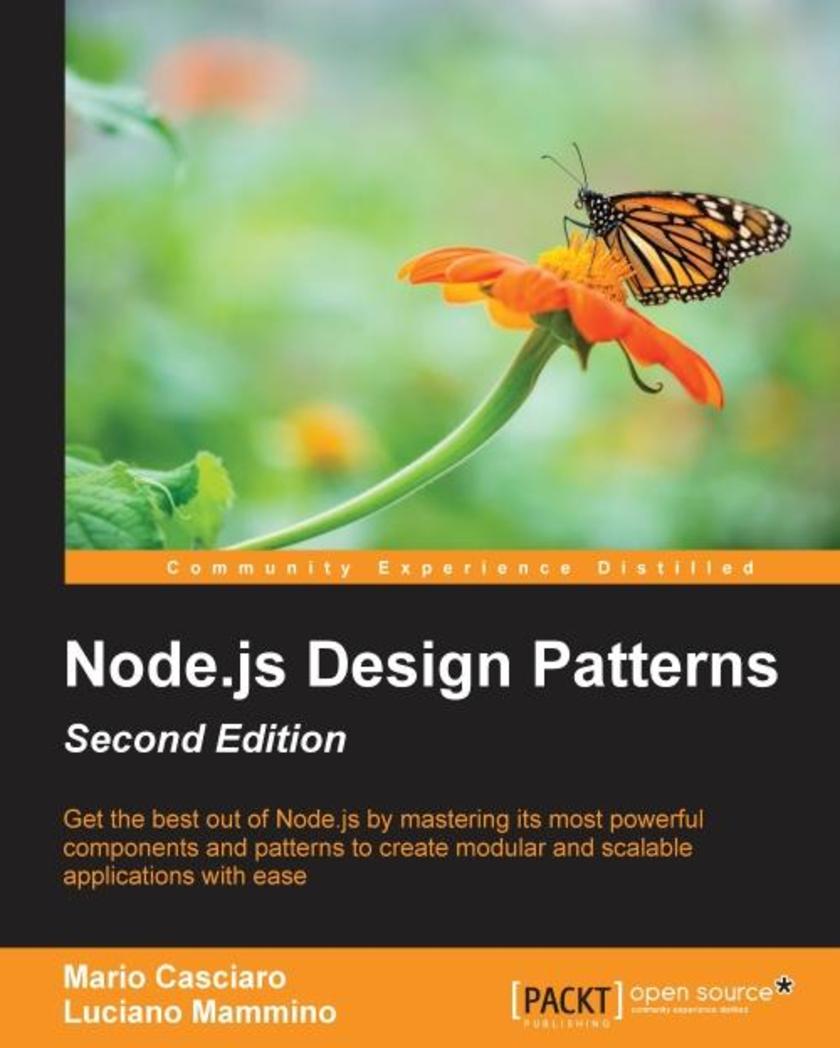
Node.js Design Patterns - Second Edition
¥90.46
Get the best out of Node.js by mastering its most powerful components and patterns to create modular and scalable applications with ease About This Book Create reusable patterns and modules by leveraging the new features of Node.js . Understand the asynchronous single thread design of node and grasp all its features and patterns to take advantage of various functions. This unique guide will help you get the most out of Node.js and its ecosystem. Who This Book Is For The book is meant for developers and software architects with a basic working knowledge of JavaScript who are interested in acquiring a deeper understanding of how to design and develop enterprise-level Node.js applications. Basic knowledge of Node.js is also helpful to get the most out of this book. What You Will Learn Design and implement a series of server-side JavaScript patterns so you understand why and when to apply them in different use case scenarios Become comfortable with writing asynchronous code by leveraging constructs such as callbacks, promises, generators and the async-await syntax Identify the most important concerns and apply unique tricks to achieve higher scalability and modularity in your Node.js application Untangle your modules by organizing and connecting them coherently Reuse well-known techniques to solve common design and coding issues Explore the latest trends in Universal JavaScript, learn how to write code that runs on both Node.js and the browser and leverage React and its ecosystem to implement universal applications In Detail Node.js is a massively popular software platform that lets you use JavaScript to easily create scalable server-side applications. It allows you to create efficient code, enabling a more sustainable way of writing software made of only one language across the full stack, along with extreme levels of reusability, pragmatism, simplicity, and collaboration. Node.js is revolutionizing the web and the way people and companies create their software. In this book, we will take you on a journey across various ideas and components, and the challenges you would commonly encounter while designing and developing software using the Node.js platform. You will also discover the "Node.js way" of dealing with design and coding decisions. The book kicks off by exploring the basics of Node.js describing it's asynchronous single-threaded architecture and the main design patterns. It then shows you how to master the asynchronous control flow patterns,and the stream component and it culminates into a detailed list of Node.js implementations of the most common design patterns as well as some specific design patterns that are exclusive to the Node.js world.Lastly, it dives into more advanced concepts such as Universal Java*, and scalability' and it's meant to conclude the journey by giving the reader all the necessary concepts to be able to build an enterprise grade application using Node.js. Style and approach This book takes its intended readers through a comprehensive explanation to create a scalable and efficient real-time server-side apps.
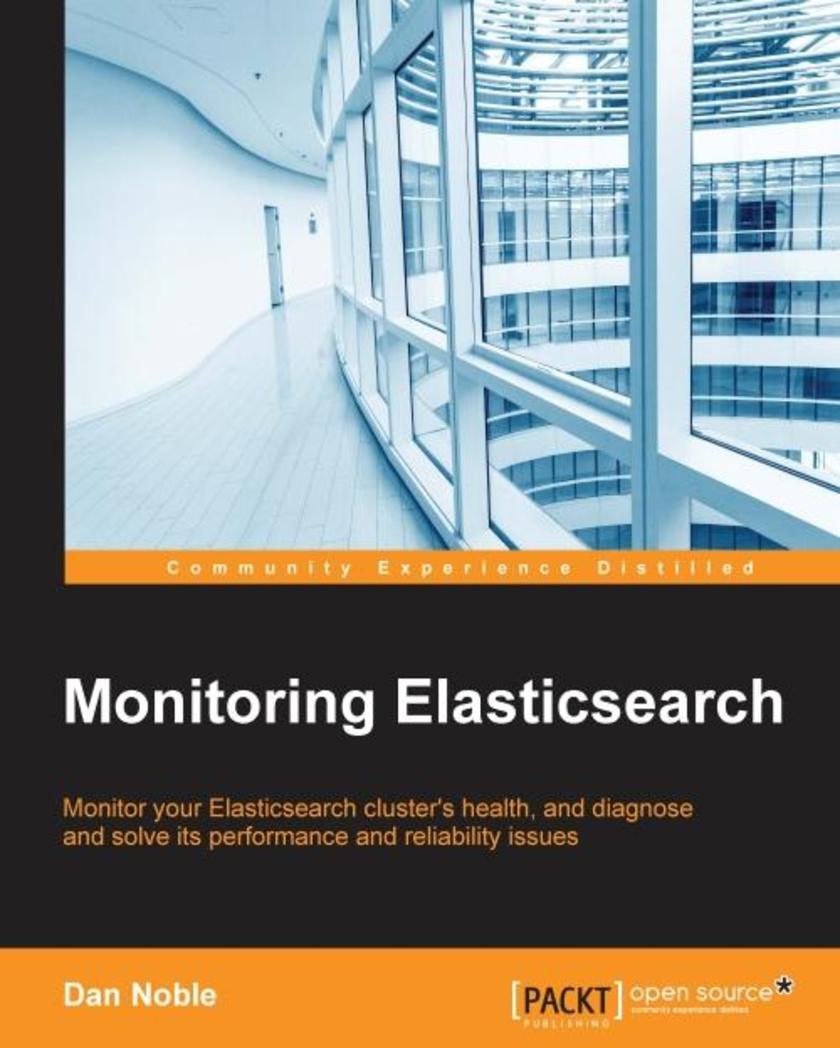
Monitoring Elasticsearch
¥63.21
Monitor your Elasticsearch cluster's health, and diagnose and solve its performance and reliability issues About This Book Understand common performance and reliability pitfalls in ElasticSearch Use popular monitoring tools such as ElasticSearch-head, BigDesk, Marvel, Kibana, and more This is a step-by-step guide with lots of case studies on solving real-world ElasticSearch cluster issues Who This Book Is For This book is for developers and system administrators who use ElasticSearch in a wide range of capacities. Prior knowledge of ElasticSearch and related technologies would be helpful, but is not necessary. What You Will Learn Explore your cluster with ElasticSearch-head and BigDesk Access the underlying data of the ElasticSearch monitoring plugins using the ElasticSearch API Analyze your cluster’s performance with Marvel Troubleshoot some of the common performance and reliability issues that come up when using ElasticSearch Analyze a cluster’s historical performance, and get to the bottom of and recover from system failures Use and install various other tools and plugins such as Kibana and Kopf, which is helpful to monitor ElasticSearch In Detail ElasticSearch is a distributed search server similar to Apache Solr with a focus on large datasets, a schema-less setup, and high availability. This schema-free architecture allows ElasticSearch to index and search unstructured content, making it perfectly suited for both small projects and large big data warehouses with petabytes of unstructured data. This book is your toolkit to teach you how to keep your cluster in good health, and show you how to diagnose and treat unexpected issues along the way. You will start by getting introduced to ElasticSearch, and look at some common performance issues that pop up when using the system. You will then see how to install and configure ElasticSearch and the ElasticSearch monitoring plugins. Then, you will proceed to install and use the Marvel dashboard to monitor ElasticSearch. You will find out how to troubleshoot some of the common performance and reliability issues that come up when using ElasticSearch. Finally, you will analyze your cluster’s historical performance, and get to know how to get to the bottom of and recover from system failures. This book will guide you through several monitoring tools, and utilizes real-world cases and dilemmas faced when using ElasticSearch, showing you how to solve them simply, quickly, and cleanly. Style and approach This is a step-by-step guide to monitoring your ElasticSearch cluster and correcting performance issues. It is filled with lots of in-depth, real-world use-cases on solving different ElasticSearch cluster issues.
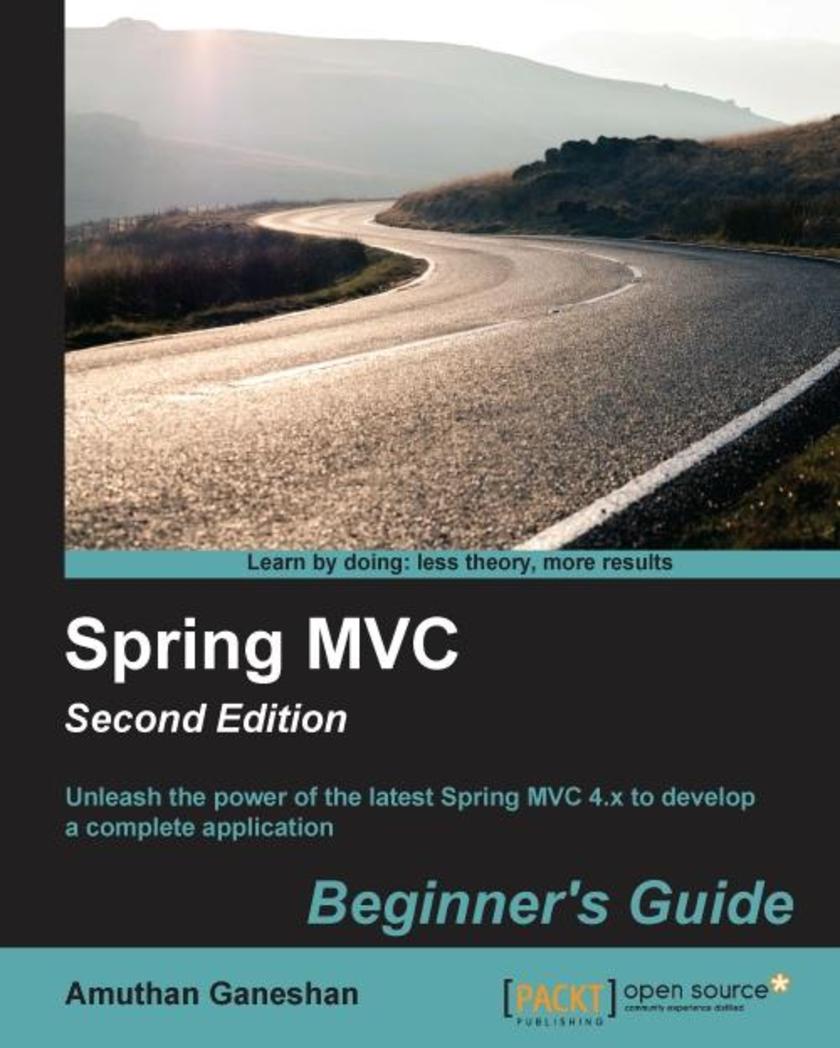
Spring MVC: Beginner's Guide - Second Edition
¥80.65
Unleash the power of the latest Spring MVC 4.x to develop a complete application About This Book Work through carefully crafted exercises with detailed explanations for each step will help you understand the concepts with ease You will gain a clear understanding of the end-to-end request/response life cycle, and each logical component’s responsibility This book is packed with tips and tricks that demonstrate industry best practices on developing a Spring-MVC-based application Who This Book Is For The book is for Java developers who want to exploit Spring MVC and its features to build web applications. Some familiarity with basic servlet programming concepts would be a plus, but is not a prerequisite. What You Will Learn Familiarize yourself with the anatomy of the Spring 4.X development environment Understand web application architecture and the Spring MVC request flow Integrate bean validation and custom validation Use error handling and exception resolving Get to grips with REST-based web service development and Ajax Test your web application In Detail Spring MVC helps you build flexible and loosely coupled web applications. The Spring MVC Framework is architected and designed in such a way that every piece of logic and functionality is highly configurable. Also, Spring can integrate effortlessly with other popular web frameworks such as Struts, WebWork, Java Server Faces, and Tapestry. The book progressively teaches you to configure the Spring development environment, architecture, controllers, libraries, and more before moving on to developing a full web application. It begins with an introduction to the Spring development environment and architecture so you're familiar with the know-hows. From here, we move on to controllers, views, validations, Spring Tag libraries, and more. Finally, we integrate it all together to develop a web application. You'll also get to grips with testing applications for reliability. Style and approach This book takes a pragmatic step-by-step approach to web application development using Spring MVC, with informative screenshots and concise explanation.
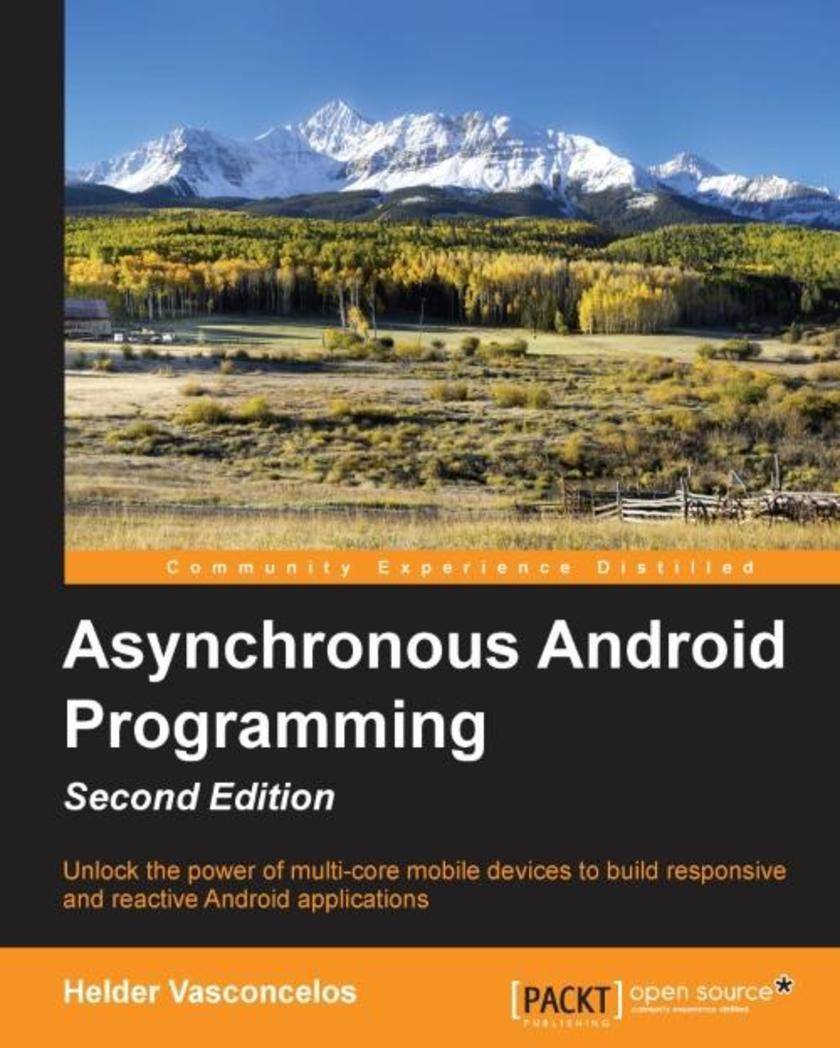
Asynchronous Android Programming - Second Edition
¥90.46
Unlock the power of multi-core mobile devices to build responsive and reactive Android applications About This Book Construct scalable and performant applications to take advantage of multi-thread asynchronous techniques Explore the high-level Android asynchronous constructs available on the Android SDK Choose the most appropriate asynchronous technique to implement your next outstanding feature Who This Book Is For This book is for Android developers who want to learn how to build multithreaded and reliable Android applications using high-level and advanced asynchronous techniques and concepts. No prior knowledge of concurrent and asynchronous programming is required. This book will also be great for Java experts who are new to Android. Whether you are a beginner at Android development or a seasoned Android programmer, this book will guide you through the most basic and advanced asynchronous constructs used in Android programming. What You Will Learn Get familiar with the android process model and low-level concurrent constructs delivered by the Android SDK Use AsyncTask and loader framework to load data in the background, delivering progress results in the meantime Create services that interact with your activity without compromising the UI rendering Learn the working of Android concurrency on the Native Layer Interact with nearby devices over Bluetooth and WiFi communications channels Create and compose tasks with RxJava to execute complex asynchronous work in a predictable way Get accustomed to the use of the Android Loader construct to deliver up-to-date results In Detail Asynchronous programming has acquired immense importance in Android programming, especially when we want to make use of the number of independent processing units (cores) available on the most recent Android devices. With this guide in your hands you’ll be able to bring the power of Asynchronous programming to your own projects, and make your Android apps more powerful than ever before! To start with, we will discuss the details of the Android Process model and the Java Low Level Concurrent Framework, delivered by Android SDK. We will also guide you through the high-level Android-specific constructs available on the SDK: Handler, AsyncTask, and Loader. Next, we will discuss the creation of IntentServices, Bound Services and External Services, which can run in the background even when the user is not interacting with it. You will also discover AlarmManager and JobScheduler APIs, which are used to schedule and defer work without sacrificing the battery life. In a more advanced phase, you will create background tasks that are able to execute CPU-intensive tasks in a native code-making use of the Android NDK. You will be then guided through the process of interacting with remote services asynchronously using the HTTP protocol or Google GCM Platform. Using the EventBus library, we will also show how to use the Publish-Subscribe software pattern to simplify communication between the different Android application components by decoupling the event producer from event consumer. Finally, we will introduce RxJava, a popular asynchronous Java framework used to compose work in a concise and reactive way. Asynchronous Android will help you to build well-behaved applications with smooth responsive user interfaces that delight the users with speedy results and data that’s always fresh. Style and approach This easy-to-follow guide is full of code examples of real-world use cases. Each asynchronous topic is explained sequentially, from the most basic and low-level to the more advanced, using concise and effective language. Some lifecycle flows and concepts feature illustrations to help you understand the complex interactions between Android entities.
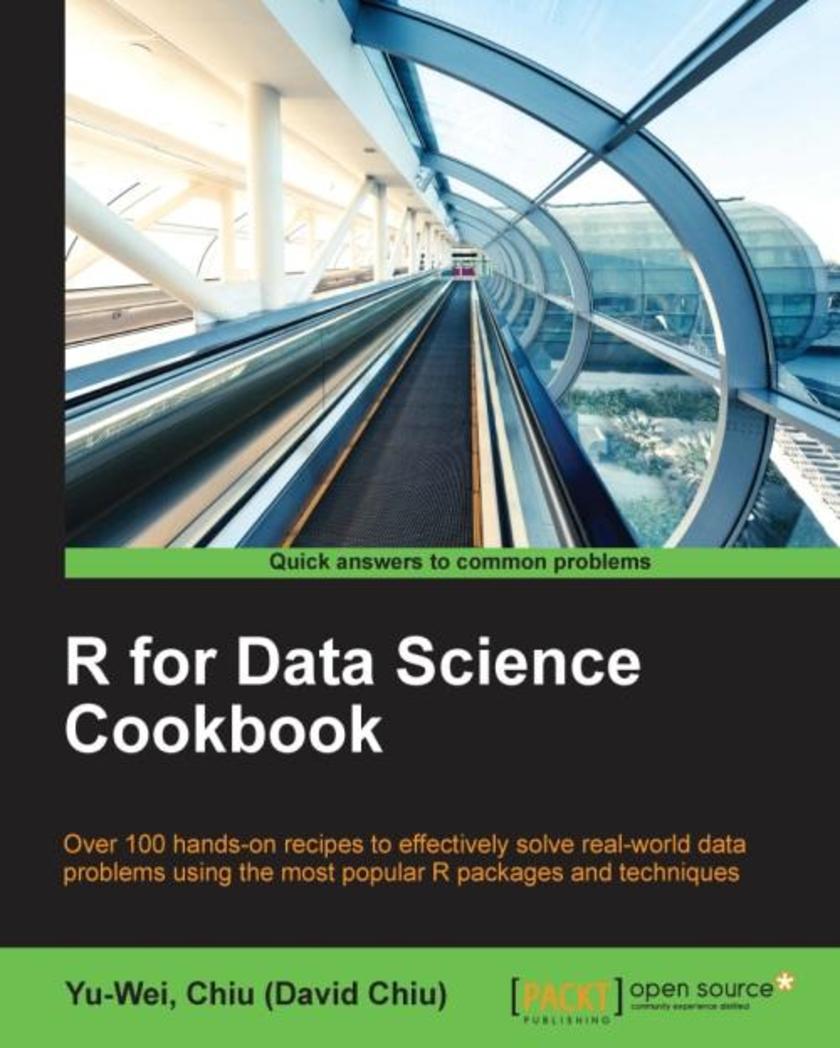
R for Data Science Cookbook
¥80.65
Over 100 hands-on recipes to effectively solve real-world data problems using the most popular R packages and techniques About This Book Gain insight into how data scientists collect, process, analyze, and visualize data using some of the most popular R packages Understand how to apply useful data analysis techniques in R for real-world applications An easy-to-follow guide to make the life of data scientist easier with the problems faced while performing data analysis Who This Book Is For This book is for those who are already familiar with the basic operation of R, but want to learn how to efficiently and effectively analyze real-world data problems using practical R packages. What You Will Learn Get to know the functional characteristics of R language Extract, transform, and load data from heterogeneous sources Understand how easily R can confront probability and statistics problems Get simple R instructions to quickly organize and manipulate large datasets Create professional data visualizations and interactive reports Predict user purchase behavior by adopting a classification approach Implement data mining techniques to discover items that are frequently purchased together Group similar text documents by using various clustering methods In Detail This cookbook offers a range of data analysis samples in simple and straightforward R code, providing step-by-step resources and time-saving methods to help you solve data problems efficiently. The first section deals with how to create R functions to avoid the unnecessary duplication of code. You will learn how to prepare, process, and perform sophisticated ETL for heterogeneous data sources with R packages. An example of data manipulation is provided, illustrating how to use the “dplyr” and “data.table” packages to efficiently process larger data structures. We also focus on “ggplot2” and show you how to create advanced figures for data exploration. In addition, you will learn how to build an interactive report using the “ggvis” package. Later chapters offer insight into time series analysis on financial data, while there is detailed information on the hot topic of machine learning, including data classification, regression, clustering, association rule mining, and dimension reduction. By the end of this book, you will understand how to resolve issues and will be able to comfortably offer solutions to problems encountered while performing data analysis. Style and approach This easy-to-follow guide is full of hands-on examples of data analysis with R. Each topic is fully explained beginning with the core concept, followed by step-by-step practical examples, and concluding with detailed explanations of each concept used.
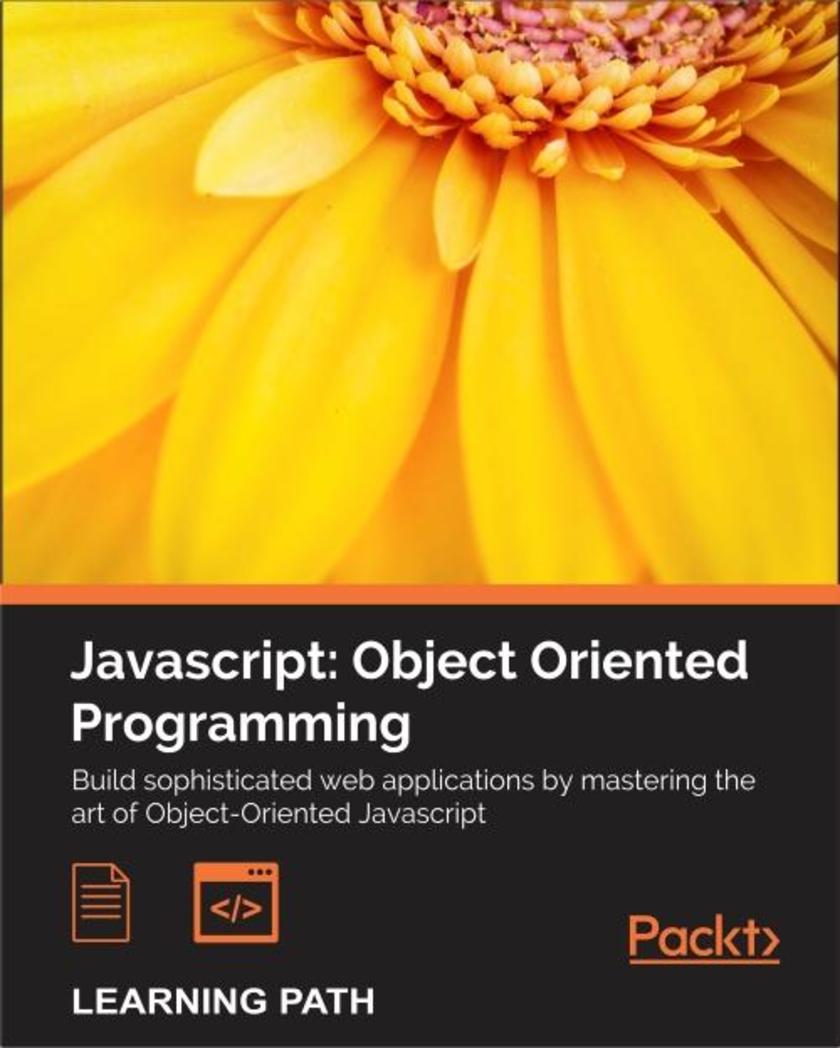
Javascript: Object Oriented Programming
¥143.87
Build sophisticated web applications by mastering the art of Object-Oriented Java* About This Book Learn popular Object-Oriented programming (OOP) principles and design patterns to build robust apps Implement Object-Oriented concepts in a wide range of frontend architectures Capture objects from real-world elements and create object-oriented code that represents them Learn the latest ES6 features and how to test and debug issues with JavaScript code using various modern mechanisms Who This Book Is For JavaScript developers looking to enhance their web developments skills by learning object-oriented programming. What You Will Learn Get acquainted with the basics of JavaScript language constructs along with object-oriented programming and its application. Learn to build scalable server application in JavaScript using Node.js Generate instances in three programming languages: Python, JavaScript, and C# Work with a combination of access modifiers, prefixes, properties, fields, attributes, and local variables to encapsulate and hide data Master DOM manipulation, cross-browser strategies, and ES6 Identify and apply the most common design patterns such as Singleton, Factory, Observer, Model-View-Controller, and Mediator Patterns Design applications using a modular architecture based on SOLID principles In Detail JavaScript is the behavior, the third pillar in today's paradigm that looks at web pages as something that consists of : content (HTML), presentation (CSS), and behavior (JavaScript). Using JavaScript, you can create interactive web pages along with desktop widgets, browser, and application extensions, and other pieces of software. Object-oriented programming, which is popularly known as OOP, is basically based on the concept of objects rather than actions. The first module will help you master JavaScript and build futuristic web applications. You will start by getting acquainted with the language constructs and how to organize code easily. You develop concrete understanding of variable scoping, loops, and best practices on using types and data structures, as well as the coding style and recommended code organization patterns in JavaScript. The book will also teach you how to use arrays and objects as data structures. By the end of the book, you will understand how reactive JavaScript is going to be the new paradigm. The second module is an easy-to-follow course, which includes hands-on examples of solutions to common problems with object-oriented code. It will help to identify objects from real-life scenarios, to protect and hide data with the data encapsulation features of Python, JavaScript, and C#. You will discover the advantage of duck typing in both Python and JavaScript, while you work with interfaces and generics in C#. With a fair understanding of interfaces, multiple inheritance, and composition, you will move on to refactor existing code and to organize your source for easy maintenance and extension. The third module takes you through all the in-depth and exciting futures hidden behind the facade. You should read through this course if you want to be able to take your JavaScript skills to a new level of sophistication. Style and approach This course is a comprehensive guide where each chapter consists of best practices, constructive advice, and few easy-to-follow examples that will build up your skills as you advance through the book. Get object oriented with this course, which takes you on a journey to get acquainted with few useful hands-on tools, features, and ways to enhance your productivity using OOP techniques. It will also act as a reference guide with useful examples on resolving problems with object-oriented code in Python, JavaScript, and C#.
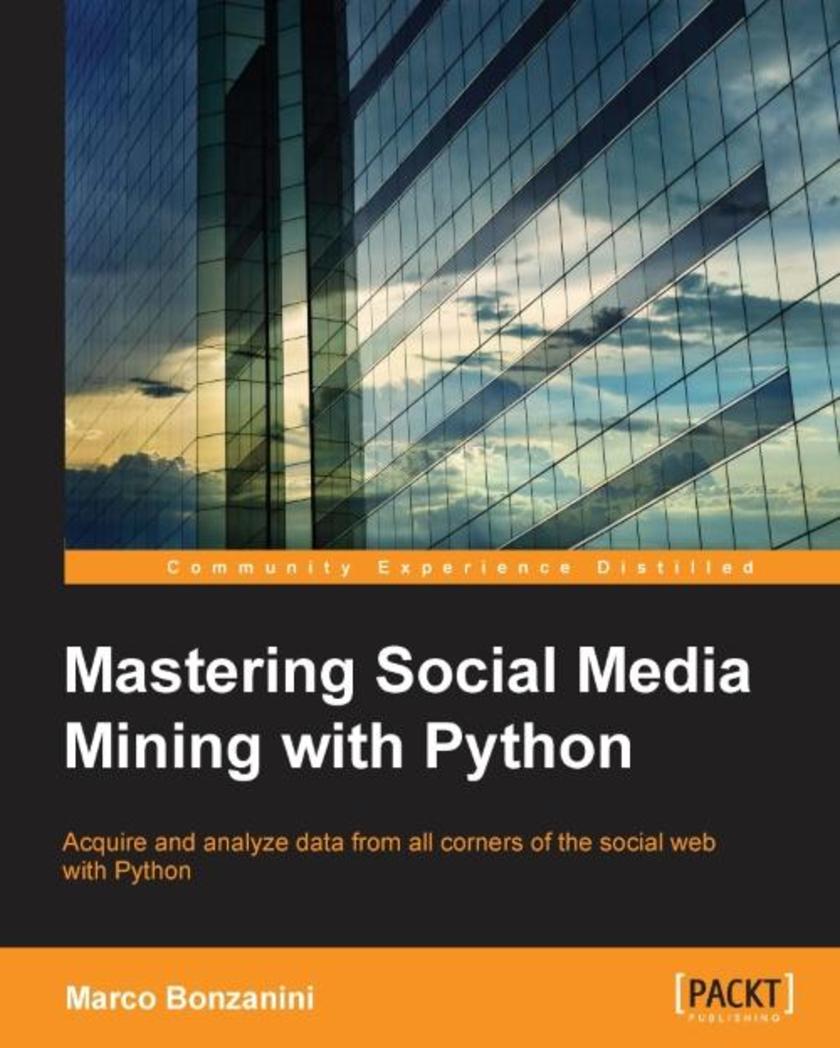
Mastering Social Media Mining with Python
¥80.65
Acquire and analyze data from all corners of the social web with Python About This Book Make sense of highly unstructured social media data with the help of the insightful use cases provided in this guide Use this easy-to-follow, step-by-step guide to apply analytics to complicated and messy social data This is your one-stop solution to fetching, storing, analyzing, and visualizing social media data Who This Book Is For This book is for intermediate Python developers who want to engage with the use of public APIs to collect data from social media platforms and perform statistical analysis in order to produce useful insights from data. The book assumes a basic understanding of the Python Standard Library and provides practical examples to guide you toward the creation of your data analysis project based on social data. What You Will Learn Interact with a social media platform via their public API with Python Store social data in a convenient format for data analysis Slice and dice social data using Python tools for data science Apply text analytics techniques to understand what people are talking about on social media Apply advanced statistical and analytical techniques to produce useful insights from data Build beautiful visualizations with web technologies to explore data and present data products In Detail Your social media is filled with a wealth of hidden data – unlock it with the power of Python. Transform your understanding of your clients and customers when you use Python to solve the problems of understanding consumer behavior and turning raw data into actionable customer insights. This book will help you acquire and analyze data from leading social media sites. It will show you how to employ scientific Python tools to mine popular social websites such as Facebook, Twitter, Quora, and more. Explore the Python libraries used for social media mining, and get the tips, tricks, and insider insight you need to make the most of them. Discover how to develop data mining tools that use a social media API, and how to create your own data analysis projects using Python for clear insight from your social data. Style and approach This practical, hands-on guide will help you learn everything you need to perform data mining for social media. Throughout the book, we take an example-oriented approach to use Python for data analysis and provide useful tips and tricks that you can use in day-to-day tasks.
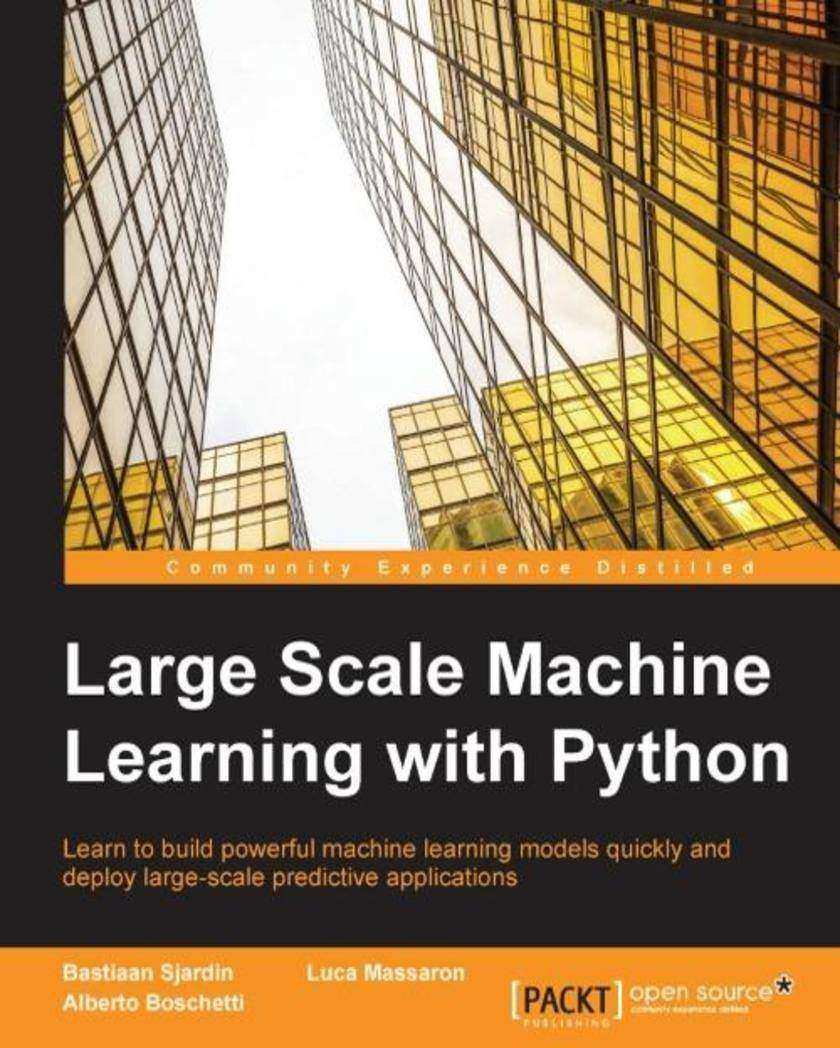
Large Scale Machine Learning with Python
¥90.46
Learn to build powerful machine learning models quickly and deploy large-scale predictive applications About This Book Design, engineer and deploy scalable machine learning solutions with the power of Python Take command of Hadoop and Spark with Python for effective machine learning on a map reduce framework Build state-of-the-art models and develop personalized recommendations to perform machine learning at scale Who This Book Is For This book is for anyone who intends to work with large and complex data sets. Familiarity with basic Python and machine learning concepts is recommended. Working knowledge in statistics and computational mathematics would also be helpful. What You Will Learn Apply the most scalable machine learning algorithms Work with modern state-of-the-art large-scale machine learning techniques Increase predictive accuracy with deep learning and scalable data-handling techniques Improve your work by combining the MapReduce framework with Spark Build powerful ensembles at scale Use data streams to train linear and non-linear predictive models from extremely large datasets using a single machine In Detail Large Python machine learning projects involve new problems associated with specialized machine learning architectures and designs that many data scientists have yet to tackle. But finding algorithms and designing and building platforms that deal with large sets of data is a growing need. Data scientists have to manage and maintain increasingly complex data projects, and with the rise of big data comes an increasing demand for computational and algorithmic efficiency. Large Scale Machine Learning with Python uncovers a new wave of machine learning algorithms that meet scalability demands together with a high predictive accuracy. Dive into scalable machine learning and the three forms of scalability. Speed up algorithms that can be used on a desktop computer with tips on parallelization and memory allocation. Get to grips with new algorithms that are specifically designed for large projects and can handle bigger files, and learn about machine learning in big data environments. We will also cover the most effective machine learning techniques on a map reduce framework in Hadoop and Spark in Python. Style and approach This efficient and practical title is stuffed full of the techniques, tips and tools you need to ensure your large scale Python machine learning runs swiftly and seamlessly. Large-scale machine learning tackles a different issue to what is currently on the market. Those working with Hadoop clusters and in data intensive environments can now learn effective ways of building powerful machine learning models from prototype to production. This book is written in a style that programmers from other languages (R, Julia, Java, Matlab) can follow.
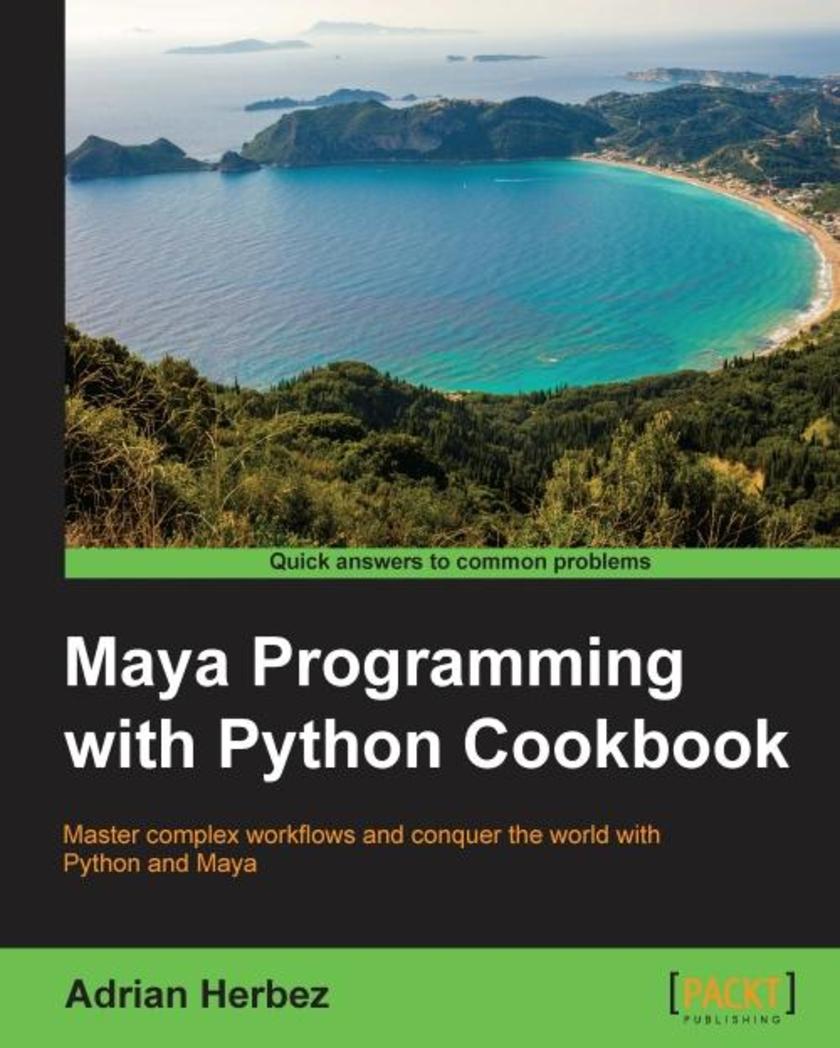
Maya Programming with Python Cookbook
¥80.65
Master complex workflows and conquer the world with Python and Maya About This Book Improve your modelling skills and reduce your *ing problems using Python in Maya Learn to communicate with web applications using Python for easier team development A quick and practical answer to every problem you can have whilst *ing in Maya with Python Who This Book Is For This book is for Python developers who have just started *ing with Maya. What You Will Learn Find out how to use Python *ing to automate tedious tasks Create functional user interfaces to make *s easy to share with others Add new functionality to Maya via the power of *ing Import and export arbitrary data into and out of Maya Improve your workflow, and that of your team Create custom create custom controls to make rigs that are easy to work with Implement a system to render 3D assets for isometric games Use * jobs to trigger actions automatically in response to user interaction Open a command port to allow other applications to communicate with Maya In Detail Maya is a 3D graphics and animation software, used to develop interactive 3D applications and games with stupendous visual effects. The Maya Programming with Python Cookbook is all about creating fast, powerful automation systems with minimum coding using Maya Python. With the help of insightful and essential recipes, this book will help you improve your modelling skills. Expand your development options and overcome *ing problems encountered whilst developing code in Maya. Right from the beginning, get solutions to complex development concerns faced when implementing as parts of build. Style and approach This book is comprised of a set of practical recipes, grouped under specific topics, which can be referred to independently or in sequence. These recipes provide quick solutions to common problems, and cover most of the real-world scenarios that developers are likely to face when working with Maya.
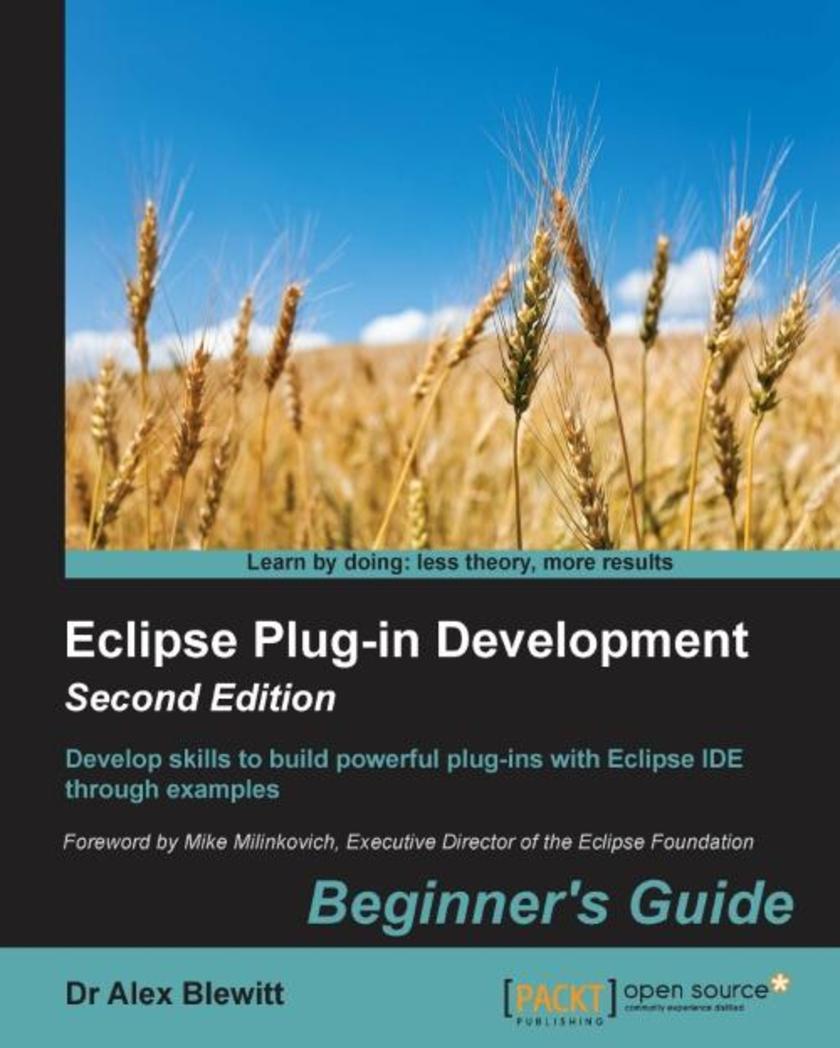
Eclipse Plug-in Development: Beginner's Guide - Second Edition
¥90.46
Develop skills to build powerful plug-ins with Eclipse IDE through examples About This Book Create useful plug-ins to make Eclipse work for you Learn how to migrate Eclipse 3.x plug-ins to Eclipse 4.x From automation to testing, find out how to get your IDE performing at an impressive standard Who This Book Is For This book is for Java developers familiar with Eclipse who need more from the IDE. This book will sharpen your confidence and make you a more productive developer with a tool that supports rather than limits you. What You Will Learn Create plug-ins for Eclipse 4.x Test plug-ins automatically with JUnit Display tree and table information in views Upgrade Eclipse 3.x plug-ins to Eclipse 4.x Find out how to build user interfaces from SWT and JFace Run tasks in the background and update the user interface asynchronously Automate builds of plug-ins and features Automate user interface tests with SWTBot In Detail Eclipse is used by everyone from indie devs to NASA engineers. Its popularity is underpinned by its impressive plug-in ecosystem, which allows it to be extended to meet the needs of whoever is using it. This book shows you how to take full advantage of the Eclipse IDE by building your own useful plug-ins from start to finish. Taking you through the complete process of plug-in development, from packaging to automated testing and deployment, this book is a direct route to quicker, cleaner Java development. It may be for beginners, but we're confident that you'll develop new skills quickly. Pretty soon you'll feel like an expert, in complete control of your IDE. Don't let Eclipse define you - extend it with the plug-ins you need today for smarter, happier, and more effective development. Style and approach Packed with plenty of examples so you're never stuck, or never left simply reading instructions, this book encourages you to get started immediately. This book is for developers who want to develop, not just learn.
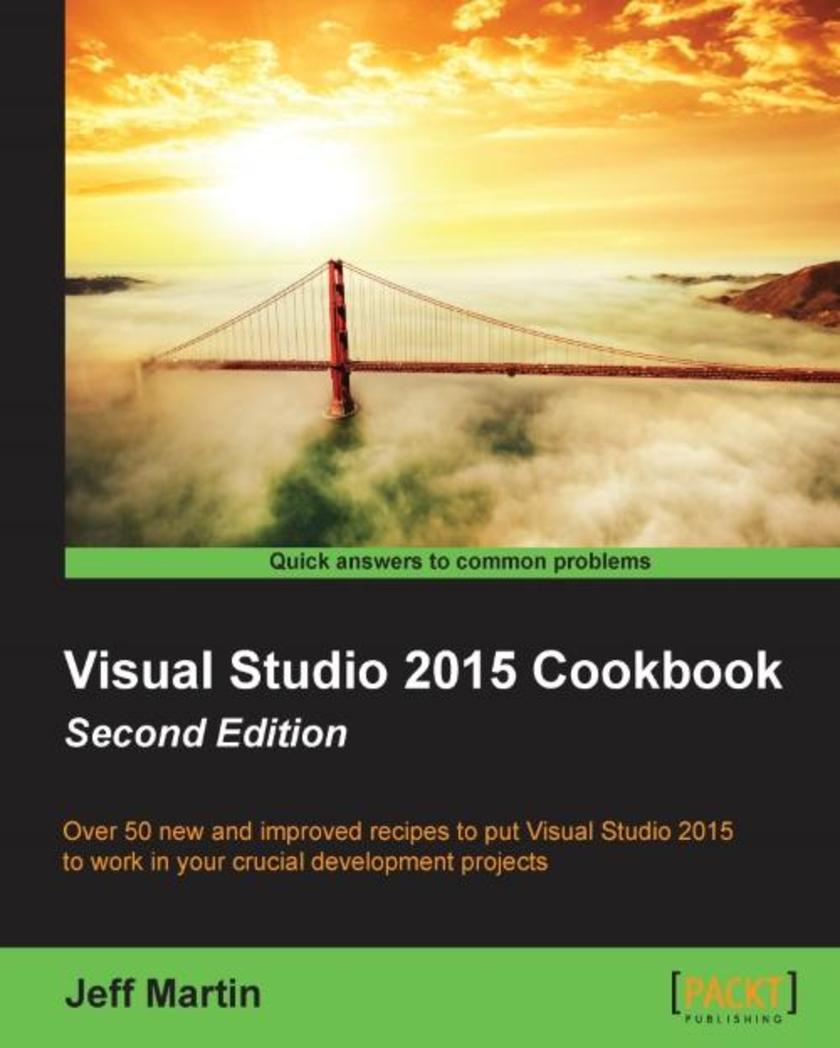
Visual Studio 2015 Cookbook - Second Edition
¥90.46
Over 50 new and improved recipes to put Visual Studio 2015 to work in your crucial development projects About This Book Get to grips with all the new Visual Studio 2015 features regardless of your preferred programming language Apply Visual Studio to all areas of development: writing, debugging, and application lifecycle maintenance Straightforward and hands-on advice for building both Windows and Android apps Who This Book Is For If you are a developer excited about the new features introduced in Visual Studio 2015, then no matter what your programming language of choice is, Visual Studio 2015 Cookbook is for you. You should have a good knowledge of working with previous versions of Visual Studio to benefit from the recipes in this book. What You Will Learn Customize the editor's new abilities to fit your development style Create apps for Windows Use Visual Studio to debug parallel and concurrent programs Integrate .NET Framework 4.6 effectively Put TypeScript to work in your web applications Develop modern C++11 with Visual Studio 2015 Protect and manage your source code with Team Foundation Server In Detail Visual Studio 2015 is the premier tool for developers targeting the Microsoft platform. Learning how to effectively use this technology can enhance your productivity while simplifying your most common tasks, allowing you more time to focus on your project. Visual Studio 2015 is packed with improvements that increase productivity, and this book walks you through each one in succession to help you smooth your workflow and get more accomplished. From customization and the interface to code snippets and debugging, the Visual Studio upgrade expands your options — and this book is your fast-track guide to getting on board quickly. Visual Studio 2015 Cookbook will introduce you to all the new areas of Visual Studio and how they can quickly be put to use to improve your everyday development tasks. With this book, you will learn not only what VS2015 offers, but what it takes to put it to work for your projects. Style and approach This book is a practical guide to using Visual Studio 2015 and will help you become familiar with the improvements made in previous versions. Each recipe provides a hands-on approach to the new features with step-by-step instructions on how to increase your productivity.




 购物车
购物车 个人中心
个人中心



